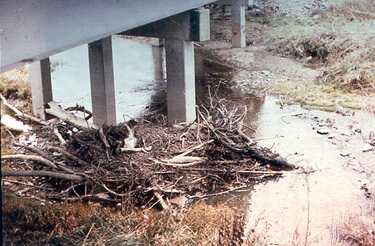
Buildup of debris around base of piers.
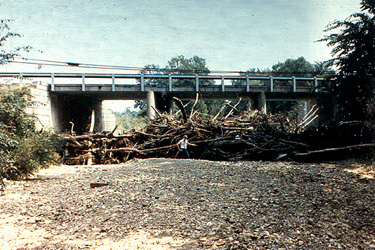
Massive accumulation of debris beneath bridge.
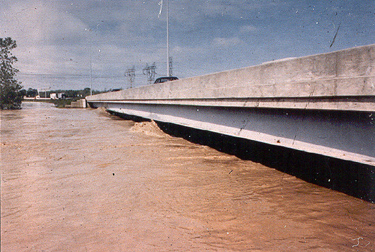
The piers interrupt the normal flow of water causing scour.
STREAMBEDS
For bridges that cross over waterways, maintenance of the underlying streambed is critically important, especially since scour (i.e., undermining of the structure's foundation) is a major cause of bridge failures nationwide. Three common waterway situations that may contribute to scour problems are: accumulation of debris beneath the bridge; streambed migration; and streambed lowering.
BUILDUP of DEBRIS
This is the most common type of problem associated with streambed maintenance. The buildup of tree limbs, branches and other debris not only increases the lateral load on the piers during periods of high flow, but also increases the likelihood of scour. Because the waterway opening is significantly reduced under the bridge, the water speed increases as it passes under the bridge. This causes scour of the streambed and if the foundations are not on piling or if the piling is not long enough, the bridge will loose its support. Some streams have a history of carrying a lot of debris during periods of high flow, and some bridges on those streams have a history of collecting debris. Bridges over these streams should be checked at least once per year and after/during every flood. Also, capped pile piers tend to collect more debris than smooth wall type or tee type piers.

Buildup of debris around base of piers. |

Massive accumulation of debris beneath bridge. |

The piers interrupt the normal flow of water causing scour. |
Preventive Maintenance Recommendations:
STREAMBED MIGRATION
Streambeds tend to naturally wander and even though the bridge was originally centered on the stream, the stream may now be off to one side of the bridge. The bridge may have been designed to have a pier on each side of the stream, but due to stream migration, the water now directly strikes a pier. This can cause undermining of the foundation (scour), which can be catastrophic, if the bridge is not on piling. In some cases, a stream runs parallel to the highway for a distance and then crosses over to the other side. In these scenarios, the bridge was built to get the highway across the stream, but the stream has a sharp bend at the bridge. These abrupt changes in stream direction also increase the likelihood of scour, because the water has to flow faster in the outside of the curve of the stream and thus causes scour of the stream bank or under foundations. Likewise, the water goes slower on the inside of the curve, which causes sediment to be deposited, which becomes a sand/gravel bar. This scouring of the outside of the stream curve and buildup along the inside of the curve feeds on itself and if left uncontrolled, can breach a bridge. It is much easier to provide bank protection (especially on the outside of stream curves) before migration presents a problem, than it is to correct an errant stream later. The most common type of bank protection is riprap or dumprock. Other types of bank protection are also available, including geotextiles and precast concrete blankets.
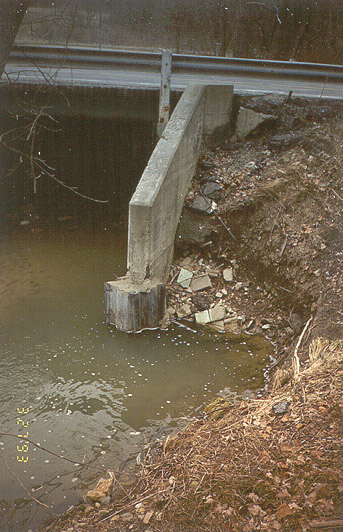
Scour behind abutment wing wall, due to lateral stream migration and misalignment with bridge. |
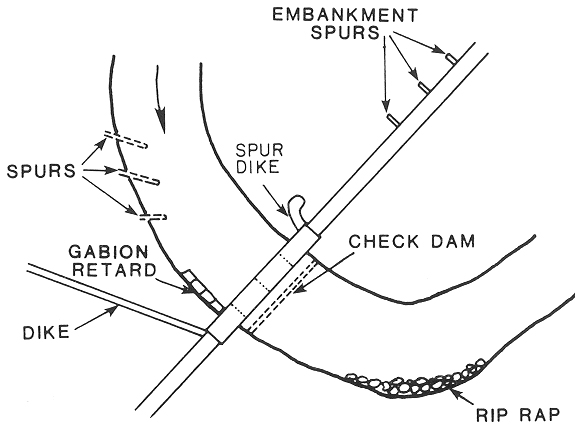
Provision of bank protection on outside of stream curve, to minimize streambed migration. |
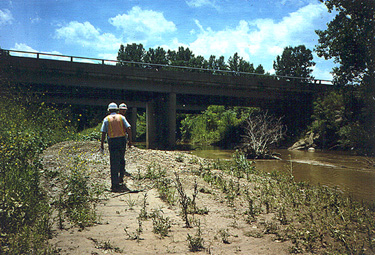
Formation of gravel bar due to lack of streambed maintenance. |
Preventive Maintenance Recommendations:
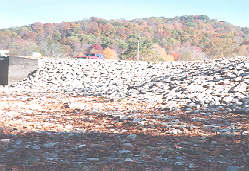
Dump rock as channel
protection
STREAMBED LOWERING
|
Streambed lowering can occur simply by normal degradation along streams with significant drops in elevation due to the topography. It can also occur as a result of individuals or companies removing gravel downstream of the bridge. In either case, streambed lowering can significantly affect the structural integrity of a bridge if the foundations were not designed for the possibility. The most common method of preventing unwanted streambed lowering is by placing riprap/dumprock across the streambed about 10' to 15' wide immediately downstream of the bridge. The riprap/dumprock cross section should be trapezoidal in shape, with the sides being higher at the top than at the bottom. On wide streambeds, a portion of the of the trapezoidal armored bottom should be slightly lower (1' to 2') to encourage the stream bed to stay in the middle of the original channel. On some larger streams, the trapezoidal weir across the channel may have to be constructed out of two transverse lines of steel sheet piling (about 20' apart) driven into the streambed 15' to 20' deep. The portion between the two lines of sheet piling is then filled with dump rock to slow the water down. |
Example of streambed lowering. |
Preventive Maintenance Recommendations: